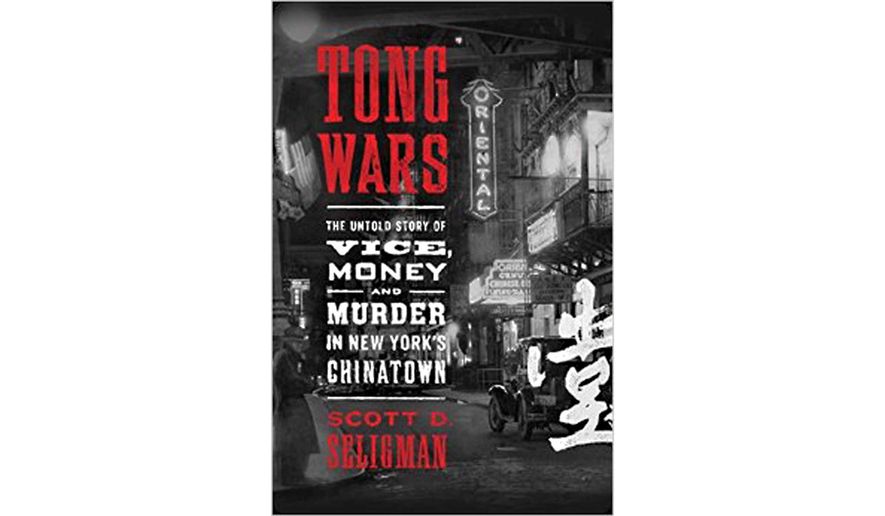OPINION:
TONG WARS: THE UNTOLD STORY OF VICE, MONEY, AND MURDER IN NEW YORK’S CHINATOWN
By Scott D. Seligman
Viking, $29, 368 pages
Historian Scott D. Seligman offers an interesting and true tale about the Chinese gang wars in New York City from the 1890s through the 1930s. The 30-year-long gang wars resulted in many brutal murders, injustice, tragedy and rampant crime and corruption. The tong wars also made lurid headlines in the newspapers of the day. How the tong wars began, how they were waged, and how they finally ended is what Mr. Seligman’s book is all about.
“This is the story of four bloody wars and countless skirmishes fought intermittently over more than three decades in New York’s Chinatown and the Chinese quarters of several other cities in America’s East and Midwest, with their attendant casualties, peace parleys, and treaties,” Mr. Seligman writes.
Mr. Seligman states that this is also the story of a veritable army of precinct captains, detectives, and uniformed officers bound and determined to stop the tong wars.
“Or at least to line their pockets,” he adds.
Mr. Seligman informs us that from the moment Chinese immigrants arrived in America they organized mutual aid societies that fell into three broad categories. The first type was the regional societies, which were organized for people from a specific area of China. The second category was clan societies, where membership was made up of Chinese who shared a common surname and were assumed to be related.
The third category were the sworn brotherhoods generally known as the “tongs,” which meant “chamber,” and were also called “triads” and secret societies.
Mr. Seligman notes that although the tongs were ostensibly benevolent associations, they came to be associated with a variety of underworld activities, such as prostitution, extortion, bribery, illegal gambling and murder.
New York’s Chinese population at the time were largely immigrant shopkeepers, laundrymen, cigar makers, and domestics. Their few diversions in a difficult life were gambling, opium, and prostitution, which were illegal. It didn’t take long, Mr. Seligman explains, before one resourceful merchant saw a golden opportunity to feather his nest by positioning himself squarely between the vice dens and the police charged with shutting them down.
Tom Lee, the longtime “mayor” of New York’s Chinatown and leader of the On Leong Tong, acted as the liaison between the Chinese merchants and residents and the New York white power elite. He was also a New York County deputy sheriff, making him the first Chinese to hold any appointed or elected government office.
We are also introduced in the book to Lee’s rivals, such as Mock Duck, the cunning and brutal leader of the Hip Sing Tong, and Sam Lock, the leader of the Four Brothers Society. The book also offers up a colorful lot of tong extortionists, blackmailers, assassins and enforcers, as well as gamblers, prostitutes, saloon owners, social reformers, journalists, clergy members, cops, Tammany Hall politicians, prosecutors, judges and lawyers.
“It would be easy to conclude from the newspapers that nearly everyone in New York’s Chinatown was either Hip Sing or On Leong,” Mr. Seligman writes. “But tong men actually always constituted only a fraction of the Chinese population. They were just the ones who got all the attention.”
Leong Gor Yun, author of “Chinatown Inside Out,” is quoted in the book, “Chinese of all classes join the tongs mostly for economic protection, sometimes for revenge. Except for the higher-ups and the hatchet-men, most of the tong members are plain victims of exploitation.”
Mr. Yun added that most of the tong members were recruited among the innocent, quiet Chinese; only when they have been oppressed or exploited to the limit of endurance, will they join either the tong of the oppressor to demand redress, or the rival tong for protection and revenge.
One tong gunfight, sparked by the murder indictment of two tong men, was described by the New York Herald as “the most spectacular and disastrous battle in the history of Chinatown.” The gunfight involved three groups of On Leongs who fired on the Hip Sings simultaneously from different locations. The Hip Sings returned fire and when the police arrived, they too began shooting, and the Chinese gangsters fired back at the police officers.
When the gunbattle was over, two innocent bystanders lay dead, as did two Hip Sings. Ten others, including two women, were wounded from the gunfight, and the flying bullets even wounded two horses. The police arrested two Hip Sings and three On Leongs and charged them all with murder. As one can imagine, this sort of thing was not good for business or the tourist trade in Chinatown.
“Tong Wars” is a well-researched and well-written story that will interest crime aficionados, as well as those interested in American history.
• Paul Davis is a writer who covers crime, espionage and terrorism




Please read our comment policy before commenting.